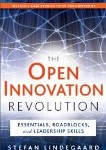Aug15
Unilever, Cisco, Whirlpool: Communication in Open Innovation
Point: Good communication skills drive open innovation and collaboration
Story: At the World Research Group’s 2010 Open Innovation Summit, many presenters stressed the role of communication for both innovation leaders and in promoting open innovation initiatives. Top-notch communication skills with senior executives, peers, partners help drive open innovation success.
Stefan Lindegaard, author of the The Open Innovation Revolution, and Greg Fox, Senior Director & CMO – Strategic Alliances at Cisco, held an invitation-only Think Tank group at the Summit to identify and discuss the key qualities of leaders of open innovation. The group ranked communications in the top
 three characteristics (vision and adaptability were also key). The Think Tank group emphasized the importance of leaders using a deliberate communications strategy with holistic internal and external communication. Good open innovation leaders have the confidence to share what they know but also maintain proper disclosure limits with open innovation partners.
three characteristics (vision and adaptability were also key). The Think Tank group emphasized the importance of leaders using a deliberate communications strategy with holistic internal and external communication. Good open innovation leaders have the confidence to share what they know but also maintain proper disclosure limits with open innovation partners.
Nona Minnifield Cheeks, Chief, Innovative Partnerships Program Office, NASA Goddard Space Flight Center noted that consistent messages and behavior (i.e., walking the talk) improve trust and outcomes. It’s vital to establish clear sense of why the organization is doing open innovation, set context, and create sense of urgency, Cheeks said.
In addition to Think Tank members, other presenters at the conference concurred about the crucial role of communications in innovation. For example, Dr. Gail Martino, Principal Scientist in the Open Innovation Group at Unilever, described seven soft skills communicators need to persuade, inspire and garner support for open innovation efforts. Communication involves being a good listener, she said, to build trust and feel empathy for others’ situations. At Unilever, top-notch communication skills include a balance of being convincing but also being an advocate for the partner. Balanced communications also include conveying both the rewards and risks of innovation, not just mindless cheerleading.
Moises Norena, Director of Global Innovation and PMR at Whirlpool Corporation, described how Whirlpool aligned innovation to strategy through Whirlpool Foundations, which communicated to all employees and helped transcend silos. Whirlpool develop training programs for all levels of employees, including a  mandatory half-hour web course that taught all employees about Whirlpool’s innovation strategy and created common language for innovation at the appliance maker. Cisco‘s Sharon Wong recommended that open innovation platform operators communicate simply and often to maintain excitement and interest in the open innovation effort.
mandatory half-hour web course that taught all employees about Whirlpool’s innovation strategy and created common language for innovation at the appliance maker. Cisco‘s Sharon Wong recommended that open innovation platform operators communicate simply and often to maintain excitement and interest in the open innovation effort.
Jeff Boehm, Chief Marketing Officer of Invention Machine, focused his presentation on the role of communications as driver for innovation, collaboration and revenue. He explained why and how marketing or internal communications supports the use of a good innovation platform and satisfaction of top-management mandates.
Boehm suggested that three key elements are necessary — but not individually sufficient — for creating successful, ongoing innovation programs. First, offering a powerful platform for innovation helps but doesn’t guarantee that innovation occurs. A “build-it-and-they-will come” approach doesn’t work because too many people are too busy to take the time to find and participate in even the most exciting innovation initiative.
Second, top-down mandates may be necessary for engaging busy people, but mandates alone aren’t sufficient to ensure innovation participation, either. Employees typically assume that daily operational pressures trump innovation mandates, so it’s easy for them to short-change innovation or allow it to slip out of awareness over time. That implies using a third element — marketing or internal communications — to reach users, communicate the value of the program, remind them of mandates, and convey the excitement and accomplishments of the effort. For example, putting an innovation icon onto employee badges creates a natural reminder and talking point about the effort.
Boehm, who has extensive experience leading these communication efforts, listed the following four actions as the critical steps for internal communications the drive participation in innovation initiatives:
Action:
- Make innovation relevant. Ask different users (executives, peers, functional silos, external partners, etc.) about their struggles and challenges and show how the innovation initiative can help them.
- Promote innovation. Create a roadmapped stream of communications that spans time and multiple channels (e.g., lunchroom posters, emails, newsletters, tent cards, tchotchkes, badges) to reach, inform, and encourage people to participate.
- Provide easy calls to action for innovation. Avoid obstacles such as convoluted registrations, approvals processes, and delays.
- Sustain the momentum of innovation with ongoing communications. Continuously relay successes, platform improvements, ongoing activities, training, and new information to avoid attenuation of attention to innovation.
Open Innovation Summit Think Tank Members:
- Greg Fox, Senior Director & CMO – Strategic Alliances, Cisco
- Dr. Andrew G. Gilicinski, Director, R&D – Innovation Networks, Clorox
- Jeff Boehm, Executive Vice President & Chief Marketing Officer, Invention Machine
- Dr. Jan M.K. Jaferian, VP Intellectual Property Manitowoc Foodservice
- Stefan Lindegaard, Founder & Chief Facilitator, 15inno.com
- Nona Minnifield Cheeks, MBA, Chief – Innovation Partnerships Program Office, NASA Goddard Space Flight Center
- Andrea Meyer, MLIS, President, Working Knowledge
To join the 2nd Annual Open Innovation Summit LinkedIn group, click here.










